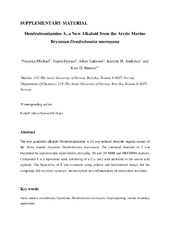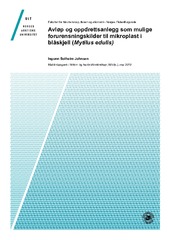Norges fiskerihøgskole: Nye registreringer
Viser treff 921-940 av 1751
-
Temperature dependent growth rate, lipid content and fatty acid composition of the marine cold-water diatom Porosira glacialis
(Journal article; Tidsskriftartikkel; Peer reviewed, 2018-11-27)In this study, the northern cold-water marine diatom <i>Porosira glacialis</i> was cultivated in a pilot-scale mass cultivation system at 5 different temperatures (−2 to 12 °C), in order to evaluate temperature-dependent growth rate (in vitro Chl <i>a</i>), lipid content (Folch's method) and fatty acid (FA) composition (GC–MS) in the exponential growth phase. We found that <i>P. glacialis</i> has a ... -
Antiviral defense in salmonids – Mission made possible?
(Journal article; Tidsskriftartikkel; Peer reviewed, 2019-01-30)Viral diseases represent one of the major threats for salmonid aquaculture. Survival from viral infections are highly dependent on host innate antiviral immune defense, where interferons are of crucial importance. Neutralizing antibodies and T cell effector mechanisms mediate long-term antiviral protection. Despite an immune cell repertoire comparable to higher vertebrates, farmed fish often fail ... -
Brood‐stock management and early hatchery rearing of Arctic charr (Salvelinus alpinus (Linnaeus))
(Journal article; Tidsskriftartikkel; Peer reviewed, 2019-12-02)Arctic charr (<i>Salvelinus alpinus</i> (Linnaeus)) is a stenothermic cold‐water fish, which has been cultured in Northern Europe and North America since the 1980s. The industry has remained relatively small with an annual production between 6000 and 10 000 tonnes, and is still challenged by an unreliable offspring production. This review focuses on offspring production in Arctic charr aquaculture ... -
Global ecological, social and economic impacts of marine plastic
(Journal article; Tidsskriftartikkel; Peer reviewed, 2019-03-27)This research takes a holistic approach to considering the consequences of marine plastic pollution. A semi-systematic literature review of 1191 data points provides the basis to determine the global ecological, social and economic impacts. An ecosystem impact analysis demonstrates that there is global evidence of impact with medium to high frequency on all subjects, with a medium to high degree of ... -
Host-associated probiotics: a key factor in sustainable aquaculture
(Journal article; Tidsskriftartikkel; Peer reviewed, 2019-07-31)The aquaculture industry has dramatically developed during the last two decades. However, this development has, in some cases, resulted in environmental degradation, emergence of diseases, and low productivity. The need for improving disease resistance, growth performance, feed efficiency, and safe aquatic production for human consumption has stimulated development and applications of probiotics in ... -
Lactic acid bacteria in shellfish: Possibilities and challenges
(Journal article; Tidsskriftartikkel; Peer reviewed, 2019-11-04)Several investigations have investigated the gut microbiota in shellfish species, but less information is available on the favorable gut bacteria colonizing the GI tract, the lactic acid bacteria (LAB), and these studies have revealed the presence of <i>Carnobacterium, Enterococcus, Lactobacillus, Lactococcus, Leuconostoc, Pediococcus, Streptococcus, Vagococcus</i>, and <i>Weissella</i>. Identification ... -
Dendrobeaniamine A, a new alkaloid from the Arctic marine bryozoan Dendrobeania murrayana
(Journal article; Tidsskriftartikkel; Peer reviewed, 2019-02-20)The new guanidine alkaloid Dendrobeaniamine A (1) was isolated from the organic extract of the Arctic marine bryozoan <i>Dendrobeania murrayana</i>. The chemical structure of 1 was elucidated by spectroscopic experiments, including 1D and 2D NMR and HRESIMS analysis. Compound 1 is a lipoamino acid, consisting of a C<sub>12</sub> fatty acid anchored to the amino acid arginine. The bioactivity of 1 ... -
Willingness to pay to protect cold water corals
(Journal article; Tidsskriftartikkel; Peer reviewed, 2019-08-16)There is increasing pressure to use currently untapped resources in the deep sea, raising questions regarding ecosystem service trade‐offs in these often unknown areas. We assessed the trade‐offs between protection of cold‐water coral reefs and economic activities, such as fisheries and petroleum extraction, through a survey of a representative sample of the populations of Norway and Ireland. ... -
Embryonic development in corkwing wrasse, Symphodus melops
(Journal article; Tidsskriftartikkel; Peer reviewed, 2019-04-10)Corkwing wrasse, <i>Symphodus melops</i>, is one of the main species used as cleaner fish to combat sea lice infestation in salmon aquaculture; however, there is little knowledge about its biology. Here, we describe the embryonic development of this species and examine the viability of the eggs under three temperature regimes. The experiments were conducted at three water temperature regimes, 12, ... -
Found in translation: identifying ecosystem services through public consultation statements in a marine spatial planning process
(Journal article; Tidsskriftartikkel; Peer reviewed, 2019-04-15)There has been a widespread push to incorporate ecosystem services (ES) in research and policy-making, yet ES have remained an expert-driven discourse not well integrated into hands-on planning and management, particularly at the more local levels. We carry out a retrospective investigation of an inter-municipal marine spatial planning (MSP) process in Northern Norway, where the allocation of new ... -
Catch-based aquaculture in Norway - Institutional challenges in the development of a new marine industry
(Journal article; Tidsskriftartikkel; Peer reviewed, 2019-03-12)Catch-based aquaculture (CBA) is an important production system in many parts of the world, especially in developing countries. In Norway CBA is based on capture and storage/farming of mature, North-east Atlantic (NEA) cod (Gadus morhua). The objective is to reduce seasonal variations and add value, by storing/farming fish to take advantage of higher prices in low seasons. Despite numerous development ... -
Are Asian fresh and brackish water aquaculture production vulnerable or resilient towards climate change impacts?
(Journal article; Tidsskriftartikkel; Peer reviewed, 2019-10-18)This study analyzes fresh and brackish water aquacultures—especially carp, tilapia, and shrimp production—in major Asian aquaculture-producing countries. Different indicators have been used, involving dimensions that may be affected by climate change. High diversity is believed to indicate high adaption capacity, while resilience is estimated by known biological properties of each species. The results ... -
Områdesamarbeid i norsk havbruk
(Research report; Forskningsrapport, 2019-11-29)Rapporten beskriver funn fra områdesamarbeid i norsk havbruk i FHF-prosjektet "Havbruksforvaltning 2030". I denne studien er områdesamarbeid definert som "Samarbeid mellom to eller flere næringsaktører i havbruk innenfor et definert geografisk område". Målet med studien er å vurdere ulike former for områdesamarbeid, hvordan områdesamarbeid kan organiseres, samt å gjøre faglige betraktninger om ... -
Avløp og oppdrettsanlegg som mulige forurensningskilder til mikroplast i blåskjell (Mytilus edulis)
(Master thesis; Mastergradsoppgave, 2019-05-14)De siste 60 årene har masseproduksjonen av plast økt (Barnes et al., 2009) og lite tyder på at produksjonen av plast vil avta med det første på grunn av de samme egenskapene som gjør at plast er farlig på avveie; det er et slitesterkt materiale og vi kjenner ikke fullstendig til konsekvensene eller nedbrytningsforløpet av det. Mikroplast er små plastpartikler som kan komme fra mange ulike ... -
Quality aspects of wild caught and enhanced sea urchins (Strongylocentrotus droebachiensis)
(Master thesis; Mastergradsoppgave, 2019-05-13)Sea urchin roe is a culinary delicacy worldwide, but with global catches are down due to overfishing and diminishing stocks, interest in aquaculture has increased. Sea urchin aquaculture lacks consistency in the quality of the product, good quality sea urchin roe should be large with an orange or yellow colour, with a distinct sweet-salty taste and have the right firm texture. The main objective ... -
Fish communities in shallow coastal waters - a study of effects of season and bottom substrate
(Master thesis; Mastergradsoppgave, 2019-05-13)Fish communities in the outer part of Malangen fjord, Troms county were studied to identify seasonal and spatial variation. The fish species compositions differed between seasons and at the four different locations. Cod (Gadus morhua L.) dominated the trammel net catches at all months except in March, in which plaice and other flatfishes were the most numerous. Species richness and diversity were ... -
Hvilke ressurser kan små fiskeindustribedrifter mobilisere for å sikre seg råstoff? – En studie av relasjon mellom fiskefartøy og fiskeindustrien.
(Master thesis; Mastergradsoppgave, 2019-05-14)I Tromsø kommune finnes et mangfold av små fiskeindustribedrifter som befinner seg i en industri preget av stor konkurranse og begrensede ressurser. I tillegg er det stor usikkerhet rundt tilgang på råstoff noe som legger press på fiskeindustribedriftene. I denne næringen er det derfor essensielt å kunne mobilisere de riktige ressursene for å gjøre seg attraktiv for fiskefartøyene slik at denne ... -
Kvotefordeling av norsk vårgytende sild og havretten. Med særlig vekt på rettshistoriske, rettsdogmatiske og rettspolitiske forhold
(Master thesis; Mastergradsoppgave, 2018-12-02)Masterprosjektet presenterer en rettshistorisk, rettsdogmatisk og rettspolitisk analyse av kvotefordelingen av norsk vårgytende sild. De involverte parter er Norge, Russland, EU, Island og Færøyene. Er det slik at multilaterale avtaler om norsk vårgytende sild ikke vil lykkes dersom kvoteandeler tildelt deltakende land er vesentlig mindre enn den mengde fisk som staten kan fiske innenfor sin ... -
Mikroplast i utvalgt sjømat og andre marine produkter i Norge
(Master thesis; Mastergradsoppgave, 2018-11-30)I det seneste tiåret har det menneskeskapte plastmaterialet til stadighet blitt trukket frem som den største og raskest voksende miljøutfordringen verden står ovenfor. Undersøkelser har vist at mikroplasten er utbredt i alle havnivåer fra bunn til havoverflate i alle verdenshavene. På bakgrunn av alle rapporter og publikasjoner om plast i havet har det vokst frem bekymringer for at mennesker skal ... -
Kongekrabbe og Snøkrabbe fra Barentshavet. Utbredelse, biologi, fangst, foredling og marked.
(Master thesis; Mastergradsoppgave, 2018-11-14)Snø- og kongekrabben er begge arter som har blitt introdusert til Barentshavet. Snøkrabben ble for første gang oppdaget på Gåsbanken i nærheten av Nova Semlja. Den har siden spredd seg vestover mot Svalbard. Kongekrabben ble av russiske forskere introdusert i Øst- Barentshavet på 1960-tallet. Siden har den spredd seg inn i norske farvann og etablert seg i flere fjorder i Øst-Finnmark. Snøkrabben har ...


 English
English norsk
norsk


















